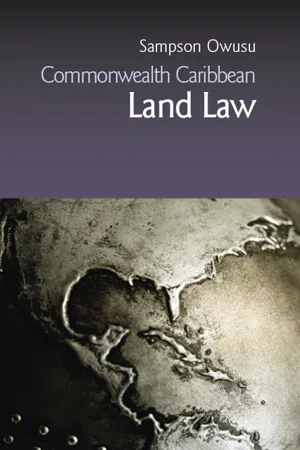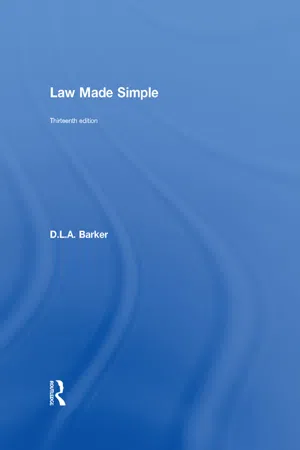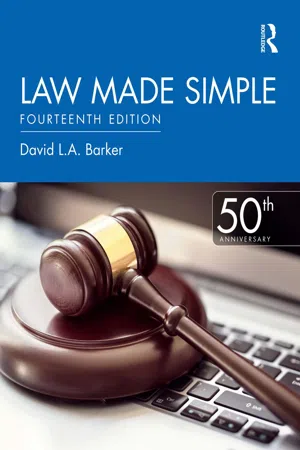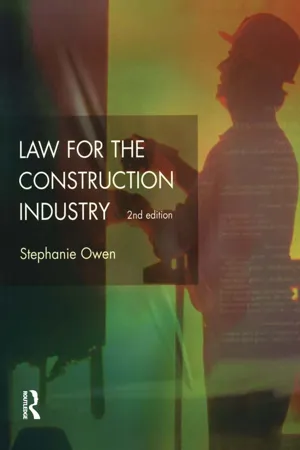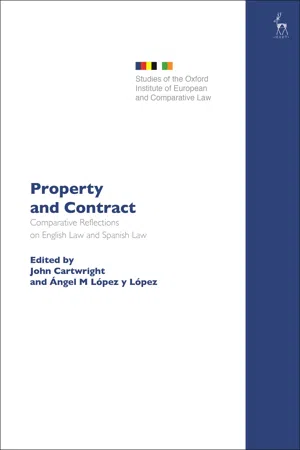Law
Property Law
Property law encompasses the rules and regulations governing the ownership, use, and transfer of real and personal property. It covers a wide range of legal issues, including property rights, landlord-tenant relationships, and property disputes. Property law aims to protect individuals' rights to possess, use, and dispose of their property while also balancing the interests of the community.
Written by Perlego with AI-assistance
7 Key excerpts on "Property Law"
Learn about this page
Index pages curate the most relevant extracts from our library of academic textbooks. They’ve been created using an in-house natural language model (NLM), each adding context and meaning to key research topics.
- eBook - ePub
- Sampson Owusu(Author)
- 2021(Publication Date)
- Routledge-Cavendish(Publisher)
CHAPTER 1DEFINITION AND CLASSIFICATION OF PROPERTY
Property connotes many things and it is therefore difficult to define. “The law of property”, according to Lawson, “attempts to answer a number of questions about the relations of persons to things”.1“Property” is used to signify things which are the subject matter of ownership, e.g., tables, books, cars – these are classified as movable things, or personal property. Land, on the other hand, is called real property. Other “things” which are valuable, but which exist as concepts and not as objects capable of being reduced to physical possession, such as corporate stocks, bonds, patents and copyrights, are referred to as intangible personal property or choses in action.A contract involves a relationship between persons respecting a thing, but its principal role lies in the enforcement of promises. Many other relations between persons affecting things do not have anything to do with promises. Contract primarily gives rise to a relationship which is in personam, i.e., a relation between two persons; only the parties to the contract can sue and be sued on it. All other persons are not affected and are, therefore, excluded.Property, on the other hand, denotes a right in rem. This means that it gives rise to rights which are enforceable not only against the parties to the transaction, but against the whole world.The distinction between contractual and property rights becomes blurred when a contract creates a right which can be transferred or assigned. Such a right becomes an asset, which can be expressed in terms of monetary value and is therefore protected against invasion by all other persons.Invasion of one’s person is protected by law against the whole world, just as any right in rem - eBook - ePub
- David Barker(Author)
- 2014(Publication Date)
- Routledge(Publisher)
Chapter 10The law of propertyKey points
● the distinction between ownership and possession● classification of property● the division of estates into freehold and leasehold● comparison of the strict settlement and the trust for sale● the role of easements and servitudes● creation and termination of the various forms of mortgage10.1 OwnershipOwnership has been described as ‘the entirety of the powers of use and disposal allowed by law’ (Pollock: First Book of Jurisprudence ). The owner of a thing has an aggregate of rights, namely (i) the right of enjoyment, (ii) the right of destruction and (iii) the right of disposition, subject to the right of others. Thus if A owns a hat he or she can wear it, alter it, burn it or merely throw it away. There are, however, limits to these rights. If A throws the hat at B , this might be an assault on B (or a battery if the hat strikes B ), for under the general law B has a right not to be interfered with. Similarly in regard to land, A may enjoy and use it, sell it or give it away; but use of this land is subject to the rights of others as allowed by law, e.g. in nuisance and tort. Today a landowner’s rights are much circumscribed by legislation aimed at social control, e.g. the Town and Country Planning Acts 1971 and 1990, the Countryside and Rights of Way Act 2000 and the Planning and Compulsory Purchase Act 2004. Permission for any change in the use of the land owned has to be obtained from the local planning authorities. Moreover, Government departments and local authorities may compulsorily acquire privately owned land and use it for public purposes, e.g. as a site for a school or college. A person may own land notwithstanding that another has an easement, such as a right of way, over it.As already mentioned, the ownership of land grew out of possession. An early landowner’s rights were possessory, and in medieval law title to the land was based on the concept of seisin - Michael Stockdale, Rebecca Mitchell, Stephen Wilson, Simon Spurgeon, Russell Hewitson, Mick Woodley(Authors)
- 2010(Publication Date)
- Routledge(Publisher)
12
Land law
Classification of property
Land is one of a number of kinds of property which can be owned, so it is useful to establish the meaning of the word ‘property’ and then to attempt to classify types of property. When considering sale of goods we saw that the word ‘property’ was used in the special sense of ‘ownership’. The more general meaning of the word is, simply, anything capable of being owned.The various categories of property are so diverse (e.g. land, jewellery, cars, stocks and shares, patents, money) that it is not surprising that the law has needed to develop different rules for each type to cover buying, selling or other transfer. Of course, if you buy a loaf of bread, it can be handed over to you. The same is not true when you buy land. A transaction involving land may be far more complex, especially when several people may have different rights over the same property at the same time. A person may own a house in which a tenant is currently living. The house may be mortgaged to a building society, and the owner may have leased shooting and fishing rights on the land and granted rights of way. This is a simple example but it serves to illustrate why the rules relating to land can be complex.Obvious ways to divide property of all types are into things which are movable or immovable, or things which are tangible or intangible. Unfortunately, English law has not used either of these classifications, but instead divides all property into that which is real and that which is personal. This might be simple if real property consisted of land and personal property was everything else. But real property consists only of freehold interests in land, so (for historical reasons) leasehold interests are classed as personal property. As the terms ‘real’ and ‘personal’ do not conjure up as clear a picture of what they cover as the other classifications, it is interesting to note the derivation of the names. Historically, English law has always given preferential treatment to land and interests in land. If a person had his freehold land wrongfully taken from him the law would ensure that he could recover it by means of a ‘real’ action. If any other type of property was wrongfully taken from him the law merely allowed him to make a claim for damages against the wrongdoer, by means of ‘personal’ action. So property came to be classified according to the type of court action needed to protect it, which accounts for the anomalous classification of leasehold interests in land.- eBook - ePub
- David L.A. Barker(Author)
- 2020(Publication Date)
- Routledge(Publisher)
Hannah v Peel , 1945). As a general rule the right to take action in respect of trespass to land inheres in the occupier (i.e. the person in possession), for it is the right of possession or the enjoyment of possession that is disturbed or infringed by trespass.The word ‘property’ has several meanings, and in law we must be careful to distinguish between two of them.10.3 Property
- Property may mean the thing or things capable of ownership. In this sense the word includes not only physical (or corporeal) things such as a pen, desk, watch and land, but also non-physical (incorporeal) things such as patent rights, copyrights, debts, etc. This is the popular sense of the term ‘property’.
- Property may mean ownership . Thus, we may say in law that ‘A has the property in a watch’, or in other words, ‘A owns a watch’. Both statements mean the same. In a sale of goods where, for example, a student buys a pen, the shop assistant hands the pen to the buyer, and, at the same time, passes ‘the property in the goods’ (i.e. the ownership) to the buyer by delivery on the sale.
Classification of property . English law has classified property in various ways. Land, the main source of wealth, is by the very nature of things treated differently from most other kinds of property, as we shall see later. Property may be divided into two classes:- real property (i.e. freehold interests in land); and
- personal property , which may be subdivided into:
- chattels real and
- chattels personal.
FIGURE 10.1 Property rights‘Chattels real’ means leaseholds in land. ‘Chattels personal’ comprises choses in action and choses in possession .The meaning of the terms mentioned above are explained in the following pages.Real property . In medieval law property was said to be ‘real’ if the courts of law would restore to a dispossessed owner the thing (res ) itself. For example, if A , the owner of freehold land (the term freehold will be explained later) were dispossessed or evicted or turned out of their land by B, A could bring a ‘real’ action against B - Richard M. Levy(Author)
- 2019(Publication Date)
- Routledge(Publisher)
If the project is a new real estate development, contracts with architects and contractors will establish the terms of work, cost, schedules, and penalties. Once the project is complete, tenants will sign leases with terms that specify rents, duration, and other requirements. The law specifies the rights and responsibilities of both parties. When disputes arise, the courts must resolve which party violated the term of the lease and make judgments on matters of restitution and eviction. Most real estate requires financing. The law defines the relationship between the lending institution and buyer. Familiarity with the law will prove invaluable at every stage: acquisition, financing, and development of real estate.Foundations and principles of private property
Our knowledge of private property dates back to the beginnings of written history. The Code of Hammurabi of 1750bc dictates how land may be sold, leased or used to pay debt and benefit those in possession of land.1 During the Middle Ages, land tenure served to structure relationships between the monarch and their lords and tenants.2 In Anglo-American history, private property is at the foundation in the development of our governmental institutions. To this extent, one of the missions of government is to protect the institution of private property. John Locke (1632–1704) stated: “The reason why men enter into society is the preservation of their property.” In the founding of the US, defenders of private property often cited Thomas Jefferson’s belief that the yeoman farmer would be the cornerstone of a country that promotes individual freedom and prosperity.3In the US, private property is protected under the Fifth and 14th Amendments of the Constitution. The Fifth Amendment states that no person shall be “deprived of life, liberty, or property, without due process of law”, “nor shall private property be taken for public use, without just compensation”. The adoption of the 14th Amendment in 1868 expanded the scope of the Fifth Amendment to the state governments, reaffirming that:- eBook - ePub
- J.R. Lewis, Stephanie Owen(Authors)
- 2014(Publication Date)
- Routledge(Publisher)
4Law of propertyIntroductionWhat does property mean?
What sort of property do you own? Make a list. The word property comes from the French word ‘propre’, meaning one's own, and thus property in law is anything capable of ownership.Your list should therefore include ‘things’ such as motor cars, clothes, jewellery, furniture, household goods, animals, food, cheques, copyright, patents, money and debts, as well as your house and land. You cannot own people or corporations.You will notice that out of this list some property is tangible, i.e. it can be touched or is physical. Other types of property are intangible and cannot be touched, such as copyright, patents, shares in a company, or goodwill.Possession and ownership
Property can be possessed or owned. What is the legal difference?Possession
This was recognised much earlier in history, as it is relatively easy to determine who is the possessor of something. It is a question of fact and needs no law to determine it. Because of the ease of proving possession, it is often said that ‘possession is nine tenths of the law’. Indeed, the person in possession of property has a better right to it than anyone else, except for the true owner. Thus, a squatter has rights, but only possessory rights, and they can never be better than those of the owner. If he remains on the land long enough, however, he may acquire ownership of the land by adverse possession. Similarly, if a person finds a lost ring he may have it returned to him by the police, but, if the true owner seeks its return within the limitation period, then the finder may be sued for the ring itself or its value. ‘Finders, keepers’ is only partly true.Ownership
This concept encompasses all the legal rights that can attach to property, so that the owner can do with the property whatever he wishes, including giving up possession. Ownership is therefore better than mere possession as the owner is entitled to possession as well, and can claim any property back that has been wrongly taken out of his possession. - eBook - ePub
Property and Contract
Comparative Reflections on English Law and Spanish Law
- John Cartwright, Ángel M López y López, John Cartwright, Ángel M López y López(Authors)
- 2022(Publication Date)
- Hart Publishing(Publisher)
a property right); and the extent to which the strength or validity of the property right that is thereby created or transferred can be related back to the validity of the contract – the interdependence of the contract by which the property right is created or transferred, and the property right itself.II. Contracts to Transfer Rights in Land: The Creation of Property Rights in EquityFirst, contracts to transfer rights in land – and here, the starting-point is the independence of the contract and property. We can take the simplest case of a transaction involving the sale of land, which is commonly effected in two stages. First, the contract of sale of the land is entered into as soon as the parties have come to an agreement as to the terms of the transaction (and, in particular, the price), in order to take the property off the market and to impose mutual obligations on the parties to proceed with the transaction – the obligation on the vendor to transfer his rights in the land,3 and the obligation on the purchaser to pay the price and take the transfer.4 At some later time, fixed by the contract, the transaction is ‘completed’ by the transfer of the property rights themselves. In principle, the contract and the transfer are independent, with separate requirements set by the law to make them effective: a contract for the sale of land must be in writing, containing all the expressly agreed terms of the contract and signed by both parties;5 but the transfer (‘conveyance’) of land or of an interest in land must generally be by ‘deed’6 – a written instrument which must make clear on its face that it is intended to be a deed and, in the case of a deed executed by an individual, must be signed by the person(s) entering into it, and the signature must be attested (witnessed by a person who confirms on the document that they have witnessed the signature).7 In order for the transfer to be fully effective, the transfer must be completed by registration at the Land Registry.8
